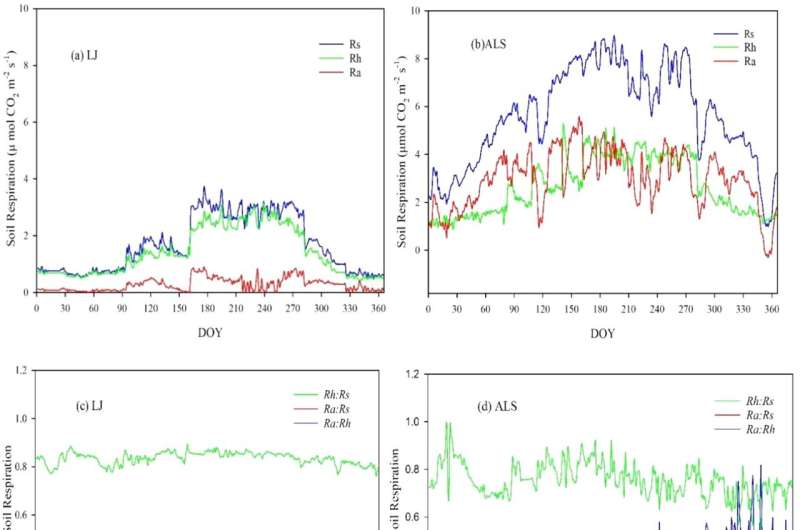
Soil respiration is the result of heterotrophic respiration (Rh) and autotrophic respiration (Ra), accounting for about 50%–75% of the total ecosystem respiration on land, which is crucial for the global carbon cycle and plays an indispensable role in biogeochemical models. With increasing global warming, understanding the response of forest soil Rh and Ra to warming is important for predicting the global carbon cycle.
In a study published in Journal of Soil Science and Plant Nutrition, researchers from the Xishuangbanna Tropical Botanical Garden (XTBG) of the Chinese Academy of Sciences conducted a soil warming experiment to evaluate the effects of warming on soil respiration in different ecosystems and the sensitivity of soil respiration to soil temperature and soil moisture content in different ecosystems.
They used a multichannel automated chamber system in both a subalpine coniferous forest in Lijiang and a subtropical evergreen broadleaf forest in Ailao Mountain, located in Yunnan Province, southwest China.
The researchers used automated multichannel soil efflux chambers to evaluate the effects of different treatments on soil respiration, including control, trenching, and trenching with warming in Lijiang and Ailao Mountain. They also analyzed the effects of soil temperature and soil moisture on soil respiration and its components, and calculated the sensitivity of soil respiration to temperature.
The results showed that soil respiration in subtropical evergreen broad-leaved forest was higher than that in subalpine coniferous forest, and the proportion of heterotrophic respiration to soil respiration was significantly higher in subalpine coniferous forest than in subtropical evergreen broad-leaved forest.
Although soil temperature and soil moisture were the main factors controlling soil respiration in both forest ecosystems, the warming effect of heterotrophic respiration was more significant when considering carbon cycle models. The greater warming effect of heterotrophic respiration in the subalpine coniferous forest was due to lower temperatures, less easily decomposable organic matter, and slower litter decomposition rates in this forest.
“Our results have important implications for understanding the contribution of soil respiration to global carbon cycling in forest ecosystems under climate warming,” said Zhang Yiping of XTBG.
More information:
Zayar Phyo et al, Comparative Analysis of Soil Respiration Dynamics and Heterotrophic Respiration Sensitivity to Warming in a Subalpine Coniferous Forest and a Subtropical Evergreen Broadleaf Forest in Southwest China, Journal of Soil Science and Plant Nutrition (2024). DOI: 10.1007/s42729-024-01852-4
Citation:
Researchers evaluate impact of warming on soil respiration in different ecosystems (2024, July 4)
retrieved 4 July 2024
from https://phys.org/news/2024-07-impact-soil-respiration-ecosystems.html
This document is subject to copyright. Apart from any fair dealing for the purpose of private study or research, no
part may be reproduced without the written permission. The content is provided for information purposes only.







